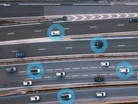Automakers are torn between Wi-Fi- and 5G-connected cars

All drivers know the stress of unwanted, unclear road conditions and the turmoil it can cause if two vehicles—or a vehicle and pedestrian—are in the wrong place at the wrong time. Road collisions are still too high for safety authorities, and even car manufacturers, to sit back and watch things unfold.
Organisations are becoming more proactive in adopting solutions to help keep drivers safe on the road, which is why connectivity is such a crucial component of future mobility. More importantly, technology integration is made much easier in electric vehicles (EVs), which adds another string of benefits to the transition from fossil-fuel-powered cars.
So how does connectivity actually support the industry and why are businesses thinking hard and fast about how to adopt connected car solutions?
Connected car systems save lives
It’s first important to understand how it works.
Connectivity in automobiles is currently split between two systems: one that is usual for short-range connection and the other for long range. Wi-Fi connectivity is the shorter range solution that allows cars to connect with other cars and share data to determine where it is going, how fast, what direction, and even understand the potential hazards in front of them.
Cellular-vehicle-to-everything (C-V2X) is the other choice of connected service, which allows further connectivity between cars and the infrastructure that surrounds them. Leveraging 5G connections, vehicles will be able to understand more about what is going on around them.
The safety aspect of this comes when you combine connected car services with on-board cameras, sensors, lidar, and radar, to encourage a full process of information and delivery. Connectivity enables information gathering, which is processed by the car, and corroborated by the solutions that monitor vehicles’ surroundings. The ultimate use of infrastructure and data allows cars to do the driving.
Cellular-vehicle-to-everything connects EVs to the world
Wi-Fi—known as dedicated short-range communication (DSRC) in cars—is used constantly in daily life, so many consumers are aware of the pros and cons; the short-distance connection and the ability for low-latency wi-fi installation in various applications.
C-V2X leverages a multitude of connections, such as vehicle-to-vehicle (V2V), vehicle-to-infrastructure (V2I), vehicle-to-pedestrian (V2P), and vehicle-to-cloud (V2C).
Such a solution is also capable of low-latency connectivity, but allows further applications to be made than simple sharing data between vehicles, including intelligent transportation management and congestion control.
Vodafone Automotive has a team dedicated to managing vehicle moments by enabling V2X connectivity, which is capable of sharing data between cars and traffic lights, road signs, and other critical infrastructure that informs drivers of road hazards and changes on their routes.
Featured products by the leading hardware developer Qualcomm, are installed in vehicle computers to enable ultra-high speeds and ultra-low latency connectivity and leverage concurrent 2G, 3G, 4G, and 5G networks.
The entrance of 5G into the world of automotive has enabled one major benefit, which is the significant reduction in latency, minimising delays to just a millisecond in applications where 4G could take up to 30 milliseconds.
With consistent connected car solutions in place, drivers will be more informed about the activities on the road ahead and carmakers hope to reduce the number of collisions, saving thousands of lives in the future.

